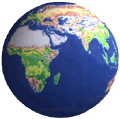

|
 In
1888, a group of explorers met to discuss the "advisability of organizing
a society for the increase and diffusion of geographical knowledge."
They would create the world's largest nonprofit scientific and educational
institution in the world. 110 years later, the National
Geographic Society continues to develop new methods of bringing
the world to millions of members. Using the expertise of the Cartographic
Applications Lab at NASA's Jet Propulsion Laboratory (JPL), the National
Geographic Society now possesses a digital satellite image map of
the world that can be used in numerous ways to support stunning and
exciting visualizations for television, and regional and global maps
for the National Geographic Society's Mapping Division. In
1888, a group of explorers met to discuss the "advisability of organizing
a society for the increase and diffusion of geographical knowledge."
They would create the world's largest nonprofit scientific and educational
institution in the world. 110 years later, the National
Geographic Society continues to develop new methods of bringing
the world to millions of members. Using the expertise of the Cartographic
Applications Lab at NASA's Jet Propulsion Laboratory (JPL), the National
Geographic Society now possesses a digital satellite image map of
the world that can be used in numerous ways to support stunning and
exciting visualizations for television, and regional and global maps
for the National Geographic Society's Mapping Division.Pulling the world together into one seamless map presented a unique challenge. JPL was a pioneer in the area of digital imaging to produce striking images from space exploration. The National Geographic Society has a high standard for visual and photographic images. The JPL Technology Affiliates Program put the National Geographic Society in touch with JPL's Cartographic Applications Lab. Dr. Nevin Bryant of JPL and his group used more than 500 NOAA Weather Satellite images acquired over the past ten years by the AVHRR (Advanced Very High Resolution Radiometer) instrument. The need to use so many images is related to both the fact that many parts of the world are cloud-covered much of the time, and the desire to use imagery that was a true 1km resolution per pixel (picture element). The AVHRR instrument, first developed at JPL in 1965 and continuously refined over the years, consists of an across-track scanner that covers a 1500km swath along its orbit track. However, this broad swath is at 1km resolution (or better) only for the center half of each scene, degrading to as much as 6.5km per pixel at the scan edges. Therefore, except for the center, most of the frame of each picture was thrown out. To obtain cloud free imagery, twice as many passes were used, getting images in early morning and mid afternoon. JPL used 10 bit data to provide 1024 discrete levels of gradations for a higher resolution picture. This greater information allows you to discern subtle features in either the rainforests of South America, the icy domes of Nepal, or the deserts of the Sahara. While others have prepared global AVHRR mosaics in recent years, JPL introduced several innovative processing steps to the preparation of this global mosaic for the National Geographic Society. Using specialized software, formulas, and expertise gained from producing images from space, JPL was able to produce a world map that meets the demanding criteria of the Society's photographic and visual standards. As a result of these innovations, the global land area mosaic is the highest resolution and most consistent representation to actual natural colors yet available. The National Geographic Society will be offering a free world map as part of their 1998 membership drive and will make avaliable a free world map to any school across the nation.. Now, with JPL's assistance, the world never looked so good. Source: Alice S. Wessen Outreach, JPL Commercial Technology alice.s.wessen@jpl.nasa.gov (818) 354-4930 http://techtrans.jpl.nasa.gov/tu.html 3/6/98
|